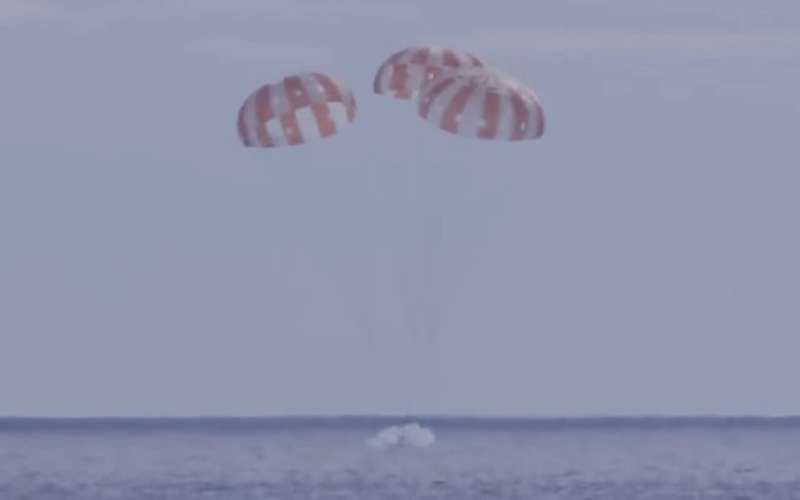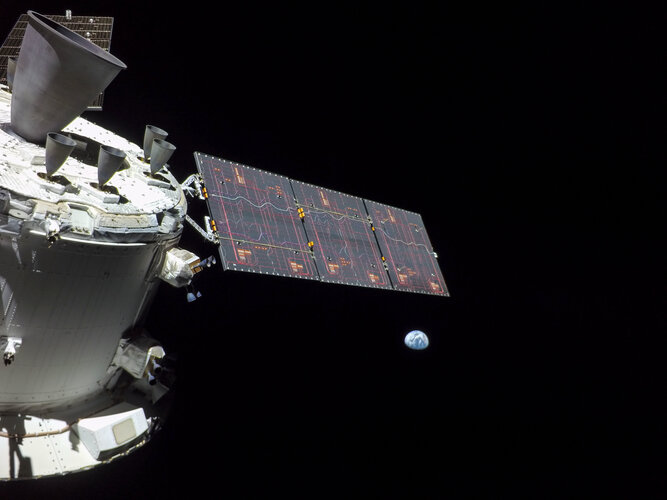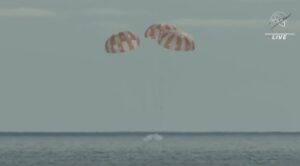NASA Orion capsule safely blazes back from moon, aces test
Sunday, 11 December 2022 17:25
NASA's Orion capsule made a blisteringly fast return from the moon Sunday, parachuting into the Pacific off Mexico to conclude a test flight that should clear the way for astronauts on the next lunar flyby.
First Artemis lunar mission ends, so long European Service Module-1
Sunday, 11 December 2022 16:51
Orion splashes down to end Artemis 1
Sunday, 11 December 2022 16:50
Fifty years to the day after the last Apollo moon mission touched down on the lunar surface, NASA’s plans to return to the moon took a major step forward with the successful splashdown of the Orion spacecraft to end the Artemis 1 mission.
Space Command promotes role in Artemis 1
Sunday, 11 December 2022 15:39
As Artemis 1 nears its conclusion, U.S. Space Command is using the mission to highlight its role in supporting NASA, even as the space agency considers alternatives to some of those services.
The post Space Command promotes role in Artemis 1 appeared first on SpaceNews.
NASA Moon capsule Orion due to splash down after record-setting voyage
Sunday, 11 December 2022 11:52 After making a close pass at the Moon and venturing further into space than any previous habitable spacecraft, NASA's Orion capsule is due to splash down Sunday in the final test of a high-stakes mission called Artemis.
As it hurtles into Earth's atmosphere at a speed of 25,000 miles (40,000 kilometers) per hour, the gumdrop-shaped traveler will have to withstand a temperature of 2,800 degre
After making a close pass at the Moon and venturing further into space than any previous habitable spacecraft, NASA's Orion capsule is due to splash down Sunday in the final test of a high-stakes mission called Artemis.
As it hurtles into Earth's atmosphere at a speed of 25,000 miles (40,000 kilometers) per hour, the gumdrop-shaped traveler will have to withstand a temperature of 2,800 degre Terran Orbital creates new Optical Solutions Group
Sunday, 11 December 2022 11:52 Terran Orbital Corporation (NYSE: LLAP), a global leader in satellite-based solutions primarily serving the aerospace and defense industries, has announced the formation of a new Optical Solutions Group (OSG) focused on electro-optical (EO) satellite imaging products. The new group will concentrate on development and innovation of new EO products while offering a wide variety of custom-made and
Terran Orbital Corporation (NYSE: LLAP), a global leader in satellite-based solutions primarily serving the aerospace and defense industries, has announced the formation of a new Optical Solutions Group (OSG) focused on electro-optical (EO) satellite imaging products. The new group will concentrate on development and innovation of new EO products while offering a wide variety of custom-made and PSLV-XL rocket motor made by industry passes test: ISRO
Sunday, 11 December 2022 11:52 The Indian Space Research Organisation (ISRO) said the performance of the booster motor made by Economic Explosives Limited for its PSLV-XL rocket was satisfactory.
The Indian space agency tested the booster motor called PSOM-XL at its rocket port in Sriharikota on Wednesday.
According to the ISRO, with this test, the private industry's capability to produce the stage for PSLV has be
The Indian Space Research Organisation (ISRO) said the performance of the booster motor made by Economic Explosives Limited for its PSLV-XL rocket was satisfactory.
The Indian space agency tested the booster motor called PSOM-XL at its rocket port in Sriharikota on Wednesday.
According to the ISRO, with this test, the private industry's capability to produce the stage for PSLV has be AFRL, CNM Ingenuity shift innovation to next level at Hyperdrive Space Summit
Sunday, 11 December 2022 11:52 The Air Force Research Laboratory, or AFRL, partnered with CNM Ingenuity, or CNMI, the economic development arm of Central New Mexico Community College, to hold the 2022 Hyperdrive Space Summit in Albuquerque, New Mexico, Nov. 15-17, 2022. The Hyperdrive Space Summit is an evolution of the Hyperspace Challenge that AFRL's Technology Outreach Office began in 2018, in collaboration with CNMI, with
The Air Force Research Laboratory, or AFRL, partnered with CNM Ingenuity, or CNMI, the economic development arm of Central New Mexico Community College, to hold the 2022 Hyperdrive Space Summit in Albuquerque, New Mexico, Nov. 15-17, 2022. The Hyperdrive Space Summit is an evolution of the Hyperspace Challenge that AFRL's Technology Outreach Office began in 2018, in collaboration with CNMI, with US grants OQ more patents for world's first 5G IoT satellite LEO constellation
Sunday, 11 December 2022 11:52 The US Patent and Trademark Office has granted OQ Technology, the pioneer of 5G IoT satellite services, patents for its "frequency synchronisation" and "timing synchronisation" technology. The two synchronisation technologies are already used for communicating with the satellites in the company's growing 5G IoT (Internet of Things) constellation connecting IoT devices globally.
Following t
The US Patent and Trademark Office has granted OQ Technology, the pioneer of 5G IoT satellite services, patents for its "frequency synchronisation" and "timing synchronisation" technology. The two synchronisation technologies are already used for communicating with the satellites in the company's growing 5G IoT (Internet of Things) constellation connecting IoT devices globally.
Following t Microchip showcases RISC-V-based FPGA and space-compute solutions at RISC-V Summit
Sunday, 11 December 2022 11:52 Mid-range FPGAs and System-on-Chip (SoC) FPGAs have played a major role in moving computer workloads to the network edge. Microchip Technology (Nasdaq: MCHP) has helped fuel this transition with its award-winning FPGAs, while also delivering the first RISC-V-based FPGAs that provide twice the power efficiency of competing mid-range FPGAs, and feature a best-in-class design, operating system and
Mid-range FPGAs and System-on-Chip (SoC) FPGAs have played a major role in moving computer workloads to the network edge. Microchip Technology (Nasdaq: MCHP) has helped fuel this transition with its award-winning FPGAs, while also delivering the first RISC-V-based FPGAs that provide twice the power efficiency of competing mid-range FPGAs, and feature a best-in-class design, operating system and Globalstar signs commercial agreement with Wiagro to supply IoT Transmitters for Agtech sector
Sunday, 11 December 2022 11:52 Globalstar, Inc. (NYSE American: GSAT) today announced a commercial agreement with Wiagro, an Agtech start-up from Argentina. Globalstar is supplying Wiagro with 2,500 ST100 satellite modem transmitters for their Smart Silobag, which allows for the remote monitoring of grain conditions stored in silo bags. The partnership is effective immediately with completion of deployment anticipated through
Globalstar, Inc. (NYSE American: GSAT) today announced a commercial agreement with Wiagro, an Agtech start-up from Argentina. Globalstar is supplying Wiagro with 2,500 ST100 satellite modem transmitters for their Smart Silobag, which allows for the remote monitoring of grain conditions stored in silo bags. The partnership is effective immediately with completion of deployment anticipated through SpaceX launches 40 Internet satellites for rival OneWeb into orbit
Sunday, 11 December 2022 11:52 SpaceX launched its 55th flight of the year on Thursday, as its Falcon 9 rocket lifted off from Kennedy Space Center, carrying 40 Internet satellites for a competitor.
Conditioners were about 90% favorable for liftoff at 5:27 p.m. EST with the three-batch deployment of the OneWeb satellites being completed about an hour and a half later.
"All 40 satellites have successfully separated
SpaceX launched its 55th flight of the year on Thursday, as its Falcon 9 rocket lifted off from Kennedy Space Center, carrying 40 Internet satellites for a competitor.
Conditioners were about 90% favorable for liftoff at 5:27 p.m. EST with the three-batch deployment of the OneWeb satellites being completed about an hour and a half later.
"All 40 satellites have successfully separated Sol 3676 Another: 'Bore-ing' Day on Mars
Sunday, 11 December 2022 11:52 After yesterday's check-out, Curiosity is GO to attempt to make our 37th drill hole on Mars. The prior plan's DRT cleaned up our target Amapari beautifully - it is in the middle of the clean area in the attached MAHLI image. Today is just a one-sol plan, but it is a full one!
Before drilling, we have a short amount of time for imaging. Drilling take a lot of time and power, so we had to li
After yesterday's check-out, Curiosity is GO to attempt to make our 37th drill hole on Mars. The prior plan's DRT cleaned up our target Amapari beautifully - it is in the middle of the clean area in the attached MAHLI image. Today is just a one-sol plan, but it is a full one!
Before drilling, we have a short amount of time for imaging. Drilling take a lot of time and power, so we had to li China launches Long March 2D carrier rocket
Sunday, 11 December 2022 11:52 China launched a Long March 2D carrier rocket early on Friday morning to transport an Earth-observation satellite into space, according to the China National Space Administration.
The rocket blasted off at 2:31 am at the Taiyuan Satellite Launch Center in northern China's Shanxi province and soon placed the Hyperspectral Multifunctional Observation Satellite into a sun-synchronous orbit 70
China launched a Long March 2D carrier rocket early on Friday morning to transport an Earth-observation satellite into space, according to the China National Space Administration.
The rocket blasted off at 2:31 am at the Taiyuan Satellite Launch Center in northern China's Shanxi province and soon placed the Hyperspectral Multifunctional Observation Satellite into a sun-synchronous orbit 70 Meteorites plus gamma rays could have given Earth the building blocks for life
Sunday, 11 December 2022 11:52 Even as detailed images of distant galaxies from the James Webb Space Telescope show us more of the greater universe, scientists still disagree about how life began here on Earth. One hypothesis is that meteorites delivered amino acids - life's building blocks - to our planet.
Now, researchers reporting in ACS Central Science have experimentally shown that amino acids could have formed in
Even as detailed images of distant galaxies from the James Webb Space Telescope show us more of the greater universe, scientists still disagree about how life began here on Earth. One hypothesis is that meteorites delivered amino acids - life's building blocks - to our planet.
Now, researchers reporting in ACS Central Science have experimentally shown that amino acids could have formed in 